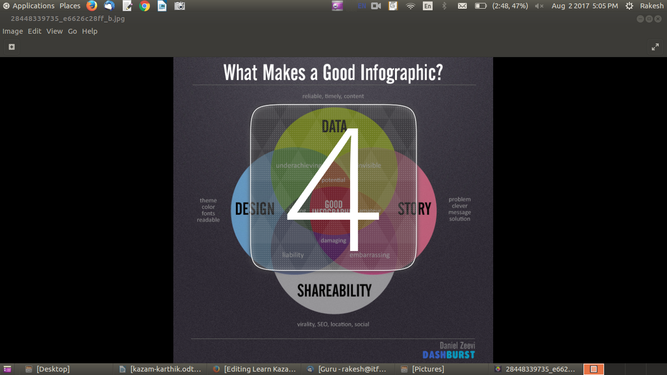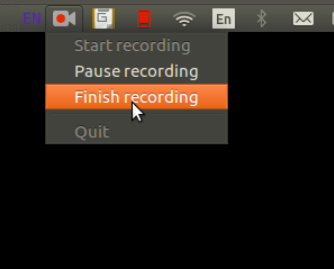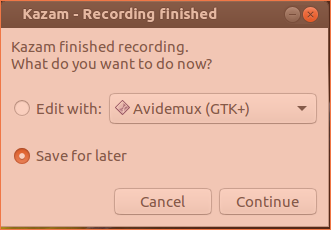परिचय
मूलभूत जानकारी
| आईसीटी सक्षमता
|
कज़म एक स्वतंत्र और खुला स्रोत अनुप्रयोग है और यह टूल (साधन) इसे स्क्रीनकास्टिंग टूल और आपके कंप्यूटर स्क्रीन के स्क्रीनशॉट लेने, दोनों के लिए उपयोग में ले सकता है।
स्क्रीनकास्टिंग: कंप्यूटर स्क्रीन आउटपुट की डिजिटल रिकॉर्डिंग, जिसे वीडियो स्क्रीन कैप्चर भी कहते हैं, जिसमें अक्सर श्रव्य विवरण भी होता है।
स्क्रीनशॉट : कंप्यूटर या मोबाइल के पर्दे पर आँकड़ों के प्रदर्शन की छवि
|
| शैक्षिक अनुप्रयोग और प्रासंगिकता
|
ऑडिओ (श्रव्य), टेक्स्ट, छवि, वीडियो और ऑडिओ डबिंग के संयोजन से वीडियो और छवि संसाधन बनाना। इसका उपयोग डिजिटल कहानी कहने की गतिविधियों में किया जा सकता है।
|
| संस्करण
|
कज़म 1.4.5
|
| अन्य समान अनुप्रयोग
|
RecordMyDesktop, Simple screen recorder
|
| मोबाइल और टैबलेट पर अनुप्रयोग
|
एंड्रॉयड मोबाइल फोनों पर इसी प्रकार के बहुत से अनुप्रयोग उपलब्ध हैं। उदाहरण,. AZ screen recorder
|
| विकास और समुदाय सहायता
|
|
विशेषताओं का संक्षिप्त-परिचय
स्थापना
- यह अनुप्रयोग उबंटू कस्टम वितरण का भाग नहीं है।
- आपको उबंटू सॉफ्टवेयर सेंटर में"कज़म"का चयन करके स्थापना करनी
- होगी। यदि आप टर्मिनल के माध्यम से स्थापना करना चाहें तो नीचे दिए गए चरणों का अनुसरण करें:
- (Ctrl+Alt+T) को क्लिक करके टर्मिनल खोलें
- एकबार विंडो पेज़ खुल गया,तो डॉलर के प्रतीक($) के सामने नीचे दिया गया कमांड टाइप करें।
- sudo apt-get install kazam
- अपना पासवर्ड टाइप करें (यह आपके पर्दे पर दिखाई नहीं देगा),प्रवेश दबाएँ।
अनुप्रयोग के साथ कार्य करना
प्रिंट स्क्रीन का उपयोग करें
यह स्क्रीनशॉट लेने की सबसे सामान्य विधि है। "प्रिंट स्क्रीन" बटन दबाने पर "दिखने वाले पूरे पर्दे" का स्क्रीनशॉट आ जाएगा।
अनुप्रयोग से परिचित होना
जब हम कज़म खोलते हैं तो हमें यह मुख्य विंडो दिखेगी। इस मुख्य विंडो में निम्नलिखित भाग हैं। अनुप्रयोगों--->Sound and Video--->Kazam से अनुप्रयोग खोलें।
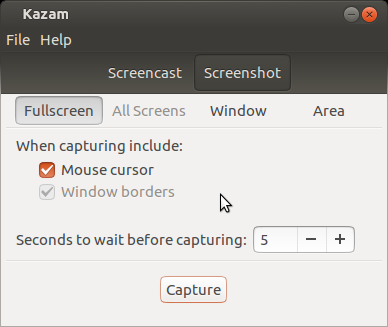 Kazam home page - स्क्रीनकास्ट: यह विकल्प स्क्रीन-कास्टिंग को व्यवस्थित करने के लिए है।
- स्क्रीनशॉट : यह विकल्प स्क्रीनशॉट को व्यवस्थित करने के लिए है।
- पूर्णस्क्रीन : इस विकल्प को चुनकर उपयोगकर्ता कंप्यूटर प्रदर्शन के पूरे स्क्रीन का स्क्रीनकास्ट/स्क्रीनशॉट करने में सक्षम हो सकता है। यह तरीका ट्यूटोरियल बनाने के लिए उपयोगी है जहाँ आपको डेस्कटॉप प्रबंधक और विभिन्न विंडो तथा अनुप्रयोगों के बीच पारस्परिक क्रिया दिखाने की आवश्यकता होती है।
- विंडो :यह विकल्प चुनकर, उपयोगकर्ता अपने कंप्यूटर स्क्रीन की केवल वर्तमान विंडो के स्क्रीनकास्ट/स्क्रीनशॉट करने में सक्षम हो सकता है। यह तरीका जो केवल एक विशेष विंडो को रिकॉर्ड करता है, एक अनुप्रयोग के स्क्रीनकास्टों को रिकॉर्ड करने के लिए आदर्श है।
- क्षेत्र : यह विकल्प चुनकर, उपयोगकर्ता अपने कंप्यूटर स्क्रीन के केवल चयनित क्षेत्र के स्क्रीनकास्ट/स्क्रीनशॉट करने में सक्षम हो सकता है। माउस कर्सर : अपनी स्क्रीनकास्ट/स्क्रीनशॉट आउटपुट फाइल में कर्सर प्वाइंट शामिल करने के लिए इस विशेषता का चयन करें।
- स्पीकर से ध्वनि : अपने स्क्रीनकास्टिंग के साथ स्पीकर आउटपुट ऑडियो जोड़ने के लिए इस विशेषता का चयन करें।
- माइक्रोफोन से ध्वनि : अपने स्क्रीनकास्टिंग के साथ अपने स्वयं के ऑडियो जोड़ने (माइक्रोफोन का उपयोग करके) के लिए इस विशेषता का चयन करें।
- कैप्चरिंग से पहले प्रतीक्षा के लिए सेकंड : Select this feature for adding your own audio (by using microphone) with our screencasting.
- Seconds to wait before capturing : This will allow us to delay to start the capture.
- Capture : This option is to start screencast/scheenshot.
Getting start with simple screenshot
When user launch the application, user will notice that in addition to recording screencast, user can also use the application to take screenshots, by switching to it at the top.
Selecting screenshot option
Delay count time for taking screenshot
After user opens kazam from menu, just click on the Screenshot option to take capture your computer screen as image. Here user can take screenshot in three modes like full screen, select window and select area.
Users can choose
- Fullscreen when they want to take full computer screen as Screenshot, they can choose (include top and buttom panel of your Ubuntu.
- Window when they want to take current window
- Area when they want particular area in the screen.
If users choose Area option, they have to drag cursor along particular area. Also users can choose whether to keep their Mouse cursor in their Screenshot and can choose to set capturing delay by few seconds before they actually start their Screenshot.
NOTE:- These options are same for both Screenshot and Screencast.
Saving screenshot
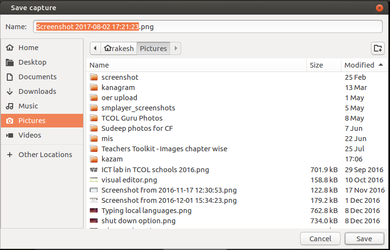 Choose location to save your screenshot After selecting above options users can click on Capture to take Screenshot.
It will prompt users to choose location for save your screenshot. Users can also change the file name before saving.
Getting start with Screen casting your computer screen
This works similar to Screenshot except that it helps users to record their computer screens along with audio and save them as videos.
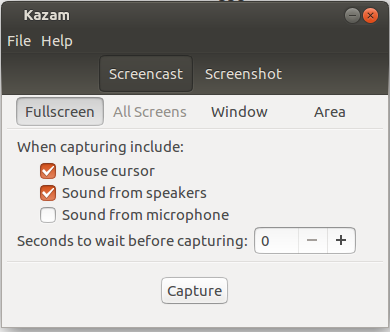 Screencast dialog box Here also users can choose whether to keep their Mouse cursor in their Screencast recording, also they can choose to record Sounds from speakers (computer audio output) and Sounds from microphone (record users input through microphone) in their recording which will help users to use their own voice or music from other sources.
Also users can choose to set capturing delay by few seconds before they actually start their recording.
After selecting above options users can click on Capture to begin Screencast.
Saving/exporting screencast
After recording a screen, users can click on Finish recording which will prompt users to choose edit it further using any video editing tools or to Save for later to save this video in computer.
Pause/Finish recording dialog box
Now users can change the project name before saving the project in their desired destination. Now project will be saved as video. This project can again be used later.
 Choose location to save your screencast Ideas for resource creation
- This is very useful for creating simple video/screenshot resources by adding narration to a process being done using an application. For example, you can run a simulation on your screen or an image slide show and add your narration to it as the application runs.
- You can also use an existing video and dub it in another language
- Please make sure that in both (1) and (2) the original visual resource/ video is licensed for reuse with modification.
References
| 
